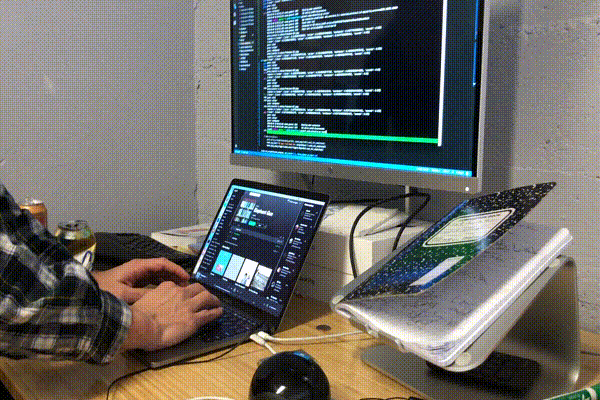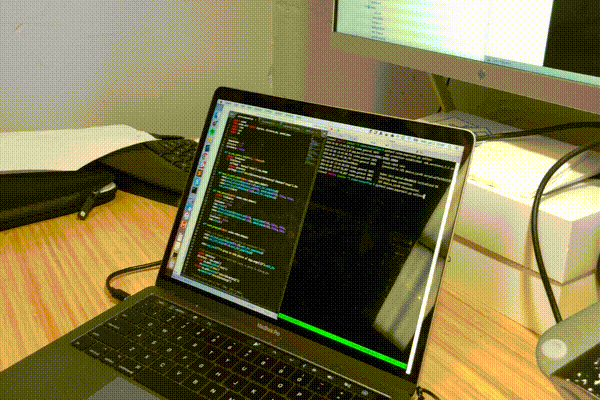Cozmo the Robot learns to recognize everyday objects using TensorFlow and FloydHub.
Install the Cozmo SDK
virtualenv ~/.env/cozmo -p python3
source ~/.env/cozmo/bin/activate
git clone https://www.github.com/whatrocks/cozmo-tensorflow
cd cozmo-tensorflow
pip install -r requirements.txtLogin to FloydHub CLI (sign up for a free account here)
floyd loginGetting enough training data for a deep learning project is often a pain. But thankfully we have a robot who loves to run around and take photos with his camera, so let's just ask Cozmo to take pictures of things we want him to learn. Let's start with a can of delicious overpriced seltzer. Place Cozmo directly in front of a bottle of seltzer, and make sure that he has enough space to rotate around the can to take some pictures. Be sure to enter the name of the object that Cozmo is photographing when you run the cozmo-paparazzi script.
python3 cozmo-paparazzi.py seltzerRepeat that step for as many objects (categories) as you want Cozmo to learn! You should now see all your image categories as subdirectories within the /data folder.
Now, let's upload our images to FloydHub as a FloydHub Dataset so that we can use them throughout our various model training and model servicing jobs.
cd data
floyd data init cozmo-images
floyd data uploadMake sure you are in our project's root directory, and then initialize a FloydHub project so that we can train our model on a fully-configured TensorFlow cloud GPU machine.
floyd init cozmo-tensorflowNow we can kick off a deep learning training job on FloydHub. Couple things to note:
- We'll be doing some simple transfer learning with the Inception v3 model provided by Google. Instead of training a model from scratch, we can start with this pre-trained model, and then replace its final layer to teach it to recognize the objects we want Cozmo to learn.
- We're mounting the dataset that Cozmo created with the
--dataflag at the/datadirectory on our FloydHub machine. - I've edited this script (initially provided by the TensorFlow team) to write its output to the
/outputdirectory. This is important when you're using FloydHub, because FloydHub jobs always store their outputs in the/outputdirectory). In our case, we'll be saving our retrained ImageNet model and the training labels to the/outputfolder.
floyd run \
--gpu \
--data whatrocks/datasets/cozmo-images:data \
"python retrain.py --image_dir /data"That's it! There's no need to configure anything on AWS or install TensorFlow or deal with GPU drivers or anything like that. If you'd like to use TensorBoard during your training jobs, just add --tensorboard to your run command.
Once your job is complete, you'll be able to see your newly retrained model in the job's output directory.
I recommend converting your job's output into a standalone FloydHub Dataset to make it easier for you to mount it in future jobs (which we're going to be doing in the next step). You can do this by clicking the 'Create Dataset' button on the job's output page.
We can test our newly retrained model by running another job on FloydHub that:
- Mounts our trained model and labels
- Sets up a public REST endpoint
Model-serving is an experimental feature on FloydHub - we'd love to hear your feedback on Twitter!. You'll need to include a simple Flask app called app.py in your project's code for this feature to work. In our case, I've created a simple Flask app that will evaluate an image using the model we trained in our last step.
floyd run \
--data whatrocks/datasets/cozmo-imagenet:model \
--mode serveFinally, let's run our cozmo-detective.py script to ask Cozmo to move around the office to find a specific object.
python3 cozmo-detective.py toothpasteEvery time that Cozmo moves, he'll send an black and white image of whatever he's seeing to the model endpoint on FloydHub - and FloydHub will run the model against this image, returning the following payload with "Cozmo's guesses" and how long it took to compute the guesses.
{
'answer':
{
'plant': 0.022327899932861328,
'seltzer': 0.9057837128639221,
'toothpaste': 0.07188836485147476
},
'seconds': 0.947
}If Cozmo is at least 80% confident that he's looking at the object in question, then he'll run towards it victoriously!
Once you are done, don't forget to shut down your FloydHub serving job on the FloydHub website!
This project is an extension of @nheidloff's Cozmo visual recognition project and the Google Code Labs TensorFlow for Poets project.

